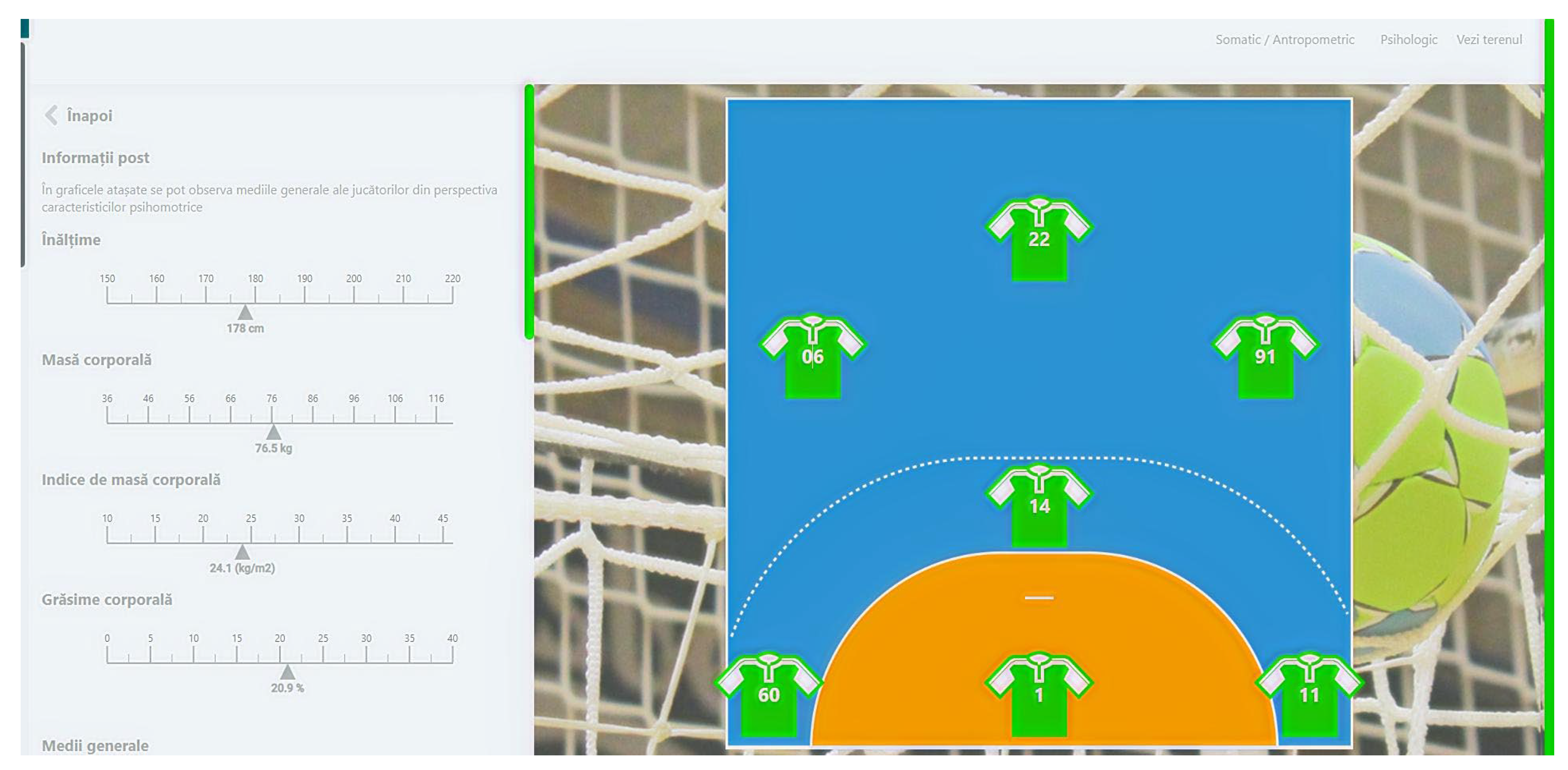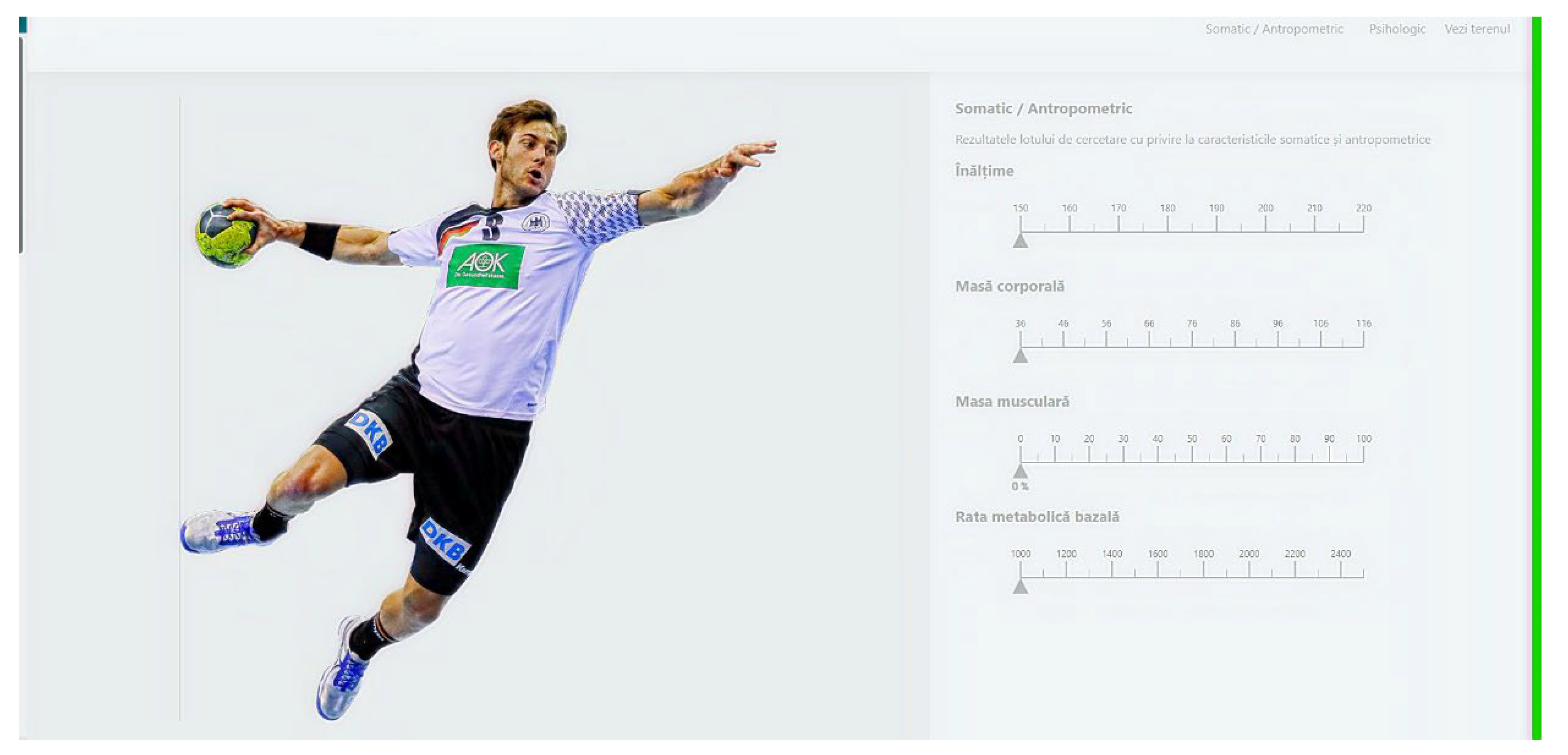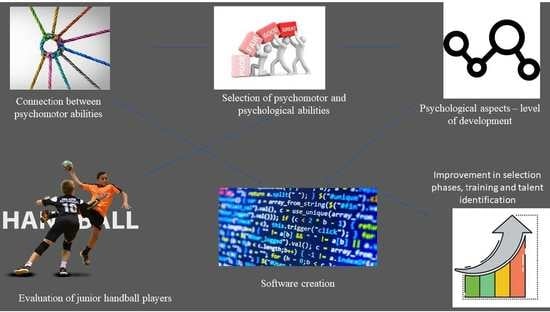The Correlation between Psychological Characteristics and Psychomotor Abilities of Junior Handball Players
Abstract
:1. Introduction
- How morphological prototypes are important for success within and among the sports phenomenon;
- An increased morphological variability in some sports compared to other disciplines or sports;
- Athletes who own or who by specific means obtain an optimal anthropometric profile for a specific sporting event are more likely to achieve success;
- Morphological optimization is useful for assessing training status and talent selection at both female and male levels.
- Assessing the level of development of certain psychomotor characteristics;
- Identifying the most important psychological characteristics that could influence the activity of junior handball players;
- Creating a performance profile of junior III handball players;
- Creating a software program that could help the training process and the selection phase by observing the general development of the players.
2. Materials and Methods
2.1. Sample
2.2. Design
2.3. Instruments
2.4. Data Analysis
2.5. Procedure
- -
- Model questions:
- -
- For motivational persistence: “I maintain my motivation even in activities that lasts for months”;
- -
- For planning: “I plan in detail what I have to do for the next day”;
- -
- For self-discipline: “Even if it’s not necessary, I put my things in order.”
3. Results
4. Discussion
5. Conclusions
Author Contributions
Funding
Institutional Review Board Statement
Informed Consent Statement
Data Availability Statement
Conflicts of Interest
References
- Gabbett, T.J. Physiological characteristics of junior and senior rugby league players. Br. J. Sports Med. 2002, 36, 334–339. [Google Scholar] [CrossRef] [PubMed] [Green Version]
- Ghuman, P.S.; Godara, H.L. The analysis of plyometric training program on university handball players. J. Sports Phys. Educ. 2013, 1, 37–41. [Google Scholar]
- Alesi, M.; Gómez-López, M.; Chicau-Borrego, C.; Monteiro, D.; Granero-Gallegos, A. Effects of a Motivational Climate on Psychological Needs Satisfaction, Motivation and Commitment in Teen Handball Players. Int. J. Environ. Res. Public Health 2019, 16, 2702. [Google Scholar] [CrossRef] [PubMed] [Green Version]
- Dosil, J. The Sport Psychologist’s Handbook a Guide for Sport-Specific Performance Enhancement; John Wiley & Sons Ltd.: Chichester, UK, 2006. [Google Scholar]
- Dosil, J. Psicología de la Actividad Física y del Deporte; McGraw-Hill: Madrid, Spain, 2004. [Google Scholar]
- Hermassi, S.; Gabbett, T.J.; Spencer, M.; Khalifa, R.; Chelly, M.S.; Chamari, K. Relationship between explosive performance measurements of the lower limb and repeated shuttle-sprint ability in elite adolescent handball players. Int. J. Sports Sci. Coach. 2014, 9, 1191–1204. [Google Scholar] [CrossRef] [Green Version]
- Massuça, L.; Fragoso, I. Morphological characteristics of adult male handball players considering five levels of performance and playing position. Coll. Antropol. 2015, 39, 109–118. [Google Scholar] [PubMed]
- Michalsik, L.; Madsen, K.; Aagaard, P. Match Performance and Physiological Capacity of Female Elite Team Handball Players. Int. J. Sports Med. 2013, 35, 595–607. [Google Scholar] [CrossRef]
- Povoas, S.C.; Seabra, A.F.; Ascensao, A.M.; Magalhaes, J.; Soares, J.M.; Rebelo, A.N. Physical and physiological demands of elite team handball. J. Strength Cond. Res. 2012, 26, 3365–3375. [Google Scholar] [CrossRef]
- Manchado, C.; Tortosa-Martínez, J.; Vila, H.; Ferragut, C.; Platen, P. Performance factors in women’s team handball: Physical an physiological aspects—A review. J. Strength Cond. Res. 2013, 27, 1708–1719. [Google Scholar] [CrossRef] [Green Version]
- Campa, F.; Silva, A.M.; Talluri, J.; Matias, C.N.; Badicu, G.; Toselli, S. Somatotype and bioimpedance vector analysis: A new target zone for male athletes. Sustainability 2020, 12, 4365. [Google Scholar] [CrossRef]
- Gorostiaga, E.M.; Granados, C.; Ibáñez, J.; Izquierdo, M. Differences in physical fitness and throwing velocity among elite and amateur male handball players. Int. J. Sport. Med. 2005, 26, 225–232. [Google Scholar] [CrossRef]
- Granados, C.; Izquierdo, M.; Ibañez, J.; Bonnabau, H.; Gorostiaga, E. Differences in physical fitness and throwing velocity among elite and amateur female handball players. Int. J. Sports Med. 2007, 28, 860–867. [Google Scholar] [CrossRef] [PubMed] [Green Version]
- Van den Tillaar, R. Comparison of range of motion tests with throwing kinematics in elite team handball players. J. Sports Sci. 2016, 34, 1976–1982. [Google Scholar] [CrossRef] [PubMed]
- Schwesig, R.; Hermassi, S.; Wagner, H.; Fischer, D.; Fieseler, G.; Molitor, T.; Delank, K.S. Relationship Between the Range of Motion and Isometric Strength of Elbow and Shoulder Joints and Ball Velocity in Women Team Handball Players. J. Strength Cond. Res. 2016, 30, 3428–3435. [Google Scholar] [CrossRef] [PubMed]
- Paul, M.; Biswas, S.K.; Sandhu, J.S. Role of sports vision and eye hand coordination training in performance of table tennis players. Braz. J. Biomotricity 2011, 5, 106–116. [Google Scholar]
- Mankowska, M.; Poliszczuk, T.; Poliszczuk, D.; Johne, M. Visual perception and its effect on reaction time and time-movement anticipation in elite female basketball players. Pol. J. Sport Tour. 2015, 22, 3–8. [Google Scholar] [CrossRef] [Green Version]
- Abbott, A.; Button, C.; Pepping, G.J.; Collins, D. Unnatural selection: Talent identification and development in sport. Nonlinear Dyn. Psychol. Life Sci. 2005, 9, 61–88. [Google Scholar]
- Kida, N.; Oda, S.; Matsumura, M. Intensive baseball practice improves the Go/Nogo reaction time, but not the simple reaction time. Cogn. Brain Res. 2005, 22, 257–264. [Google Scholar] [CrossRef]
- Yüksel, M.; Tunç, G. Examining the Reaction Times of International Level Badminton Players Under 15. Sports 2018, 6, 20. [Google Scholar] [CrossRef] [Green Version]
- Bojić, I.; Kocić, M.; Veličković, M.; Nikolić, D. Correlation between morphological characteristics and situational—Motor abilities of young female handball players. In Proceedings of the 20 Scientific Conference “FIS Communications 2017” in Physical Education, Sport and Recreation, Nis, Serbia, 19–21 October 2017; pp. 317–322. [Google Scholar]
- Ohnjec, K.; Vuleta, D.; Milanović, D.; Gruić, I. Performance indicators of teams at the 2003 World Handball Championship for women in Croatia. Kinesiology 2008, 40, 69–79. [Google Scholar]
- Spieszny, M.; Zubik, M. Modification of strength training programs in handball players and its influence on power during the competitive period. J. Hum. Kinet. 2018, 63, 149–160. [Google Scholar] [CrossRef] [Green Version]
- Hammami, M.; Gaamouri, N.; Aloui, G.; Shephard, R.J.; Chelly, M.S. Effects of combined plyometric and short sprint with change-of-direction training on athletic performance of male U15 handball players. J. Strength Cond. Res. 2018, 33, 662–675. [Google Scholar] [CrossRef] [PubMed]
- Tóth, L. The emergence, development and importance of the self and self-image. Magy. Sporttudományi Szle. 2006, 7, 6–10. [Google Scholar]
- Bebetsos, E.; Bebetsos, G. Greek youth team handball players and their satisfaction levels. Eur. Handball Mag. 2006, 1–9. [Google Scholar]
- Diehm, R.; Armatas, C. Surfing: An avenue for socially acceptable risk-taking, satisfying needs for sensation seeking and experience seeking. Personal. Individ. Differ. 2004, 36, 663–667. [Google Scholar] [CrossRef]
- Kais, K.; Raudsepp, L. Intensity and direction of competitive state anxiety, self-confidence and athletic performance. Kinesiology 2005, 37, 13–20. [Google Scholar]
- Révész, L. The Features of the Hungarian Swimming Sports in Terms of the Choice of the Branch of Sport, Selection and the Care of Talented Persons. Ph.D. Thesis, Semmelweis Egyetem, Budapest, Hungary, 2008. [Google Scholar]
- Géczi, G. Success and Talent Development as Indicated by Motor Tests and Psychometric Variables of u18 Ice Hockey Players. Ph.D. Thesis, Semmelweis Egyetem, Budapest, Hungary, 2009. [Google Scholar]
- Csáki, I.; Fózer-Selmeci, B.; Bognár, J.; Szájer, P.; Zalai, D.; Géczi, G.; Révész, L.; Tóth, L. New measurement method: Examination of psychological factors by the Vienna Test System among football players. Testnev. Sport Tudomány 2016, 1, 8–20. [Google Scholar] [CrossRef]
- Gyömbér, N.; Lénart, A.; Kovács, K. Differences between Personality Characteristics and Sport Performance by Age and Gender. Acta Fac. Educ. Phys. Univ. Comenianae. Publ. 2013, 53, 5–17. [Google Scholar]
- Tóth, L.; Géczi, G.; Bognár, J. Examination of competitive state anxiety, athletic coping strategies, and emotional attributes in Hungarian ice hockey players. Kalokagathia 2011, 49, 129–147. [Google Scholar]
- Kőnig-Görögh, D.; Gyömbér, N.; Szerdahelyi, Z.; Laoues, N.; Balogh, Z.O.; Tóth-Hosnyánszki, A.; Csaba, Ö. Personality profiles of junior handball players: Differences as a function of age, gender, and playing positions. Cogn. Brain Behav. 2017, 21, 237–247. [Google Scholar] [CrossRef]
- Massuça, L.; Fragoso, I. Study of Portuguese handball players of different playing status. A morphological and biosocial perspective. Biol. Sport 2011, 28, 37. [Google Scholar] [CrossRef] [Green Version]
- Justin, I.; Vuleta, D.; Pori, P.; Kajtna, T.; Pori, M. Are taller handball goalkeepers better? Certain characteristics and abilities of Slovenian male athletes. Kinesiol. Int. J. Fundam. Appl. Kinesiol. 2013, 45, 252–261. [Google Scholar]
- Hoff, J.; Almåsbakk, B. The effects of maximum strength training on throwing velocity and muscle strength in female team-handball players. J. Strength Cond. Res. 1995, 9, 255–258. [Google Scholar]
- Nakamoto, H.; Mori, S. Sport-specific decision-making in a Go/NoGo reaction task: Difference among nonathletes and baseball and basketball players. Percept. Mot. Ski. 2008, 106, 163–170. [Google Scholar] [CrossRef] [PubMed]
- Kioumourtzoglou, E.; Derri, V.; Tzetzls, G.; Theodorakis, Y. Cognitive, perceptual, and motor abilities in skilled basketball performance. Percept. Mot. Ski. 1998, 86, 771–786. [Google Scholar] [CrossRef] [PubMed]
- Constantin, T.; Holman, A.; Hojbotă, A. Development and Validation of a Motivational Persistence Scale. Psihologija 2011, 45, 99–120. [Google Scholar] [CrossRef]
- Kaczka, P.; Maciejczyk, M.; Batra, A.; Tabęcka-Łonczyńska, A.; Strzała, M. Acute Effect of Caffeine-Based Multi-Ingredient Supplement on Reactive Agility and Jump Height in Recreational Handball Players. Nutrients 2022, 14, 1569. [Google Scholar] [CrossRef]
- Badau, D.; Badau, A.; Ene-Voiculescu, C.; Larion, A.; Ene-Voiculescu, V.; Mihaila, I.; Fleacu, J.L.; Tudor, V.; Tifrea, C.; Cotovanu, A.S.; et al. The Impact of Implementing an Exergame Program on the Level of Reaction Time Optimization in Handball, Volleyball, and Basketball Players. Int. J. Environ. Res. Public Health 2022, 19, 5598. [Google Scholar] [CrossRef]
- Tuquet, J.; Cartón, A.; Marco-Contreras, L.A.; Mainer-Pardos, E.; Lozano, D. Analysis of the Steps Cycle in the Action of Throwing in Competition in Men’s Elite Handball. Sustainability 2022, 14, 5291. [Google Scholar] [CrossRef]
- Gomez-Lopez, M.; Granero-Gallegos, A.; Feu Molina, S.; Luis, J.; Rios, C. Relative age effect during the selection of young handball player. J. Phys. Educ. Sport 2017, 17, 418–423. [Google Scholar]
- Bjørndal, C.T.; Ronglan, L.T.; Andersen, S.S. Talent development as an ecology of games: A case study of Norwegian handball. Sport Educ. Soc. 2015, 22, 864–877. [Google Scholar] [CrossRef]
- Gómez-López, M.; Angosto, S.; Ruiz-Sánchez, V. Relative age effect in the selection process of handballplayers of the regional selection teams. E-Balonmanocom J. Sport Sci. 2017, 13, 3–14. [Google Scholar]
- Mohamed, H.; Vaeyens, R.; Matthys, S.; Multael, M.; Lefevre, J.; Lenoir, M.; Philppaerts, R. Anthropometric and performance measures for the development of a talent detection and identification model in youth handball. J. Sports Sci. 2009, 27, 257–266. [Google Scholar] [CrossRef] [PubMed]
- Lidor, R.; Falk, B.; Arnon, M.; Cohen, Y.; Segal, G.; Lander, Y. Measurement of talent in team handball: The questionable use of motor and physical tests. J. Strength Cond. Res. 2005, 19, 318–325. [Google Scholar] [CrossRef] [PubMed]
- Cobley, S.; Baker, J.; Wattie, N.; McKenna, J. Annual age-grouping and athlete development: A meta-analytical review of relative age effects in sport. Sports Med. 2009, 39, 235–256. [Google Scholar] [CrossRef] [PubMed]
- Matthys, S.P.; Fransen, J.; Vaeyens, R.; Lenoir, M.; Philippaerts, R. Differences in biological maturation, anthropometry and physical performance between playing positions in youth team handball. J. Sports Sci. 2013, 31, 1344–1352. [Google Scholar] [CrossRef]
- Reilly, T.; Bangsbo, J.; Franks, A. Anthropometric and physiological predispositions for elite soccer. J. Sports Sci. 2000, 18, 669–683. [Google Scholar] [CrossRef]



| Item 1 | 0.617 |
| Item 2 | 0.606 |
| Item 3 | 0.608 |
| Item 4 | 0.594 |
| Item 5 | 0.626 |
| Item 6 | 0.590 |
| Item 7 | 0.598 |
| Item 8 | 0.629 |
| Item 9 | 0.596 |
| Item 10 | 0.609 |
| Item 11 | 0.619 |
| Item 12 | 0.625 |
| Item 13 | 0.630 |
| Item 14 | 0.624 |
| Item 15 | 0.615 |
| Cronbach’s Alpha | 0.622 |
| Motivational Persistence | Planning | Self-Discipline | |
|---|---|---|---|
| Mean | 6.31 | 6.39 | 6.44 |
| N | 181 | 181 | 181 |
| SD | 2.52 | 2.27 | 2.30 |
| Dependent Variable | Sig. | ||
|---|---|---|---|
| Motivational persistence | Right wing | Right back | 0.764 |
| Center back | 0.003 | ||
| Left wing | 0.049 | ||
| Goalkeeper | 0.001 | ||
| Right back | Right wing | 0.764 | |
| Center back | 0.008 | ||
| Goalkeeper | 0.000 | ||
| Center back | Right wing | 0.003 | |
| Right back | 0.008 | ||
| Left back | 0.004 | ||
| Pivot | 0.000 | ||
| Goalkeeper | 0.000 | ||
| Left back | Right wing | 0.931 | |
| Center back | 0.004 | ||
| Goalkeeper | 0.001 | ||
| Left wing | Right wing | 0.049 | |
| Pivot | 0.003 | ||
| Goalkeeper | 0.000 | ||
| Left wing | 0.000 | ||
| Pivot | 0.031 | ||
| Planning | Right wing | Right back | 0.777 |
| Center back | 0.005 | ||
| Left wing | 0.020 | ||
| Goalkeeper | 0.003 | ||
| Right back | Right wing | 0.777 | |
| Center back | 0.013 | ||
| Left wing | 0.043 | ||
| Goalkeeper | 0.001 | ||
| Center back | Right wing | 0.005 | |
| Right back | 0.013 | ||
| Left back | 0.007 | ||
| Pivot | 0.015 | ||
| Goalkeeper | 0.000 | ||
| Left back | Right wing | 0.936 | |
| Center back | 0.007 | ||
| Left wing | 0.027 | ||
| Goalkeeper | 0.002 | ||
| Left wing | Right wing | 0.020 | |
| Right back | 0.043 | ||
| Left back | 0.027 | ||
| Pivot | 0.046 | ||
| Goalkeeper | 0.000 | ||
| Self-discipline | Right wing | Right back | 0.777 |
| Center back | 0.005 | ||
| Left wing | 0.000 | ||
| Goalkeeper | 0.000 | ||
| Right back | Right wing | 0.777 | |
| Centre back | 0.012 | ||
| Left wing | 0.001 | ||
| Pivot | 0.712 | ||
| Goalkeeper | 0.000 | ||
| Center back | Right wing | 0.005 | |
| Right back | 0.012 | ||
| Left back | 0.007 | ||
| Pivot | 0.007 | ||
| Goalkeeper | 0.000 | ||
| Left back | Right wing | 0.935 | |
| Agility (S) | Dynamic Balance (INCH) | General Dynamic Coordination (S) | ||
|---|---|---|---|---|
| Agility (S) | Pearson Correlation | 1 | −0.229 ** | 0.418 ** |
| Sig. (2-tailed) | 0.002 | 0.000 | ||
| N | 181 | 181 | 181 | |
| Dynamic Balance (INCH) | Pearson Correlation | −0.229 ** | 1 | −0.477 ** |
| Sig. (2-tailed) | 0.002 | 0.000 | ||
| N | 181 | 181 | 181 | |
| Sig. (2-tailed) | 0.157 | 0.581 | 0.783 | |
| N | 181 | 181 | 181 | |
| General Dynamic Coordination (S) | Pearson Correlation | 0.418 ** | −0.477 ** | 1 |
| Sig. (2-tailed) | 0.000 | 0.000 | ||
| N | 181 | 181 | 181 |
| F | Sig. | |
|---|---|---|
| Motivational persistence * planning | 411.89 | 0.000 |
| Motivational persistence * self-discipline | 603.56 | 0.000 |
| 2.85 | 0.001 | |
| Planning * self-discipline | 4262.17 | 0.000 |
| Model Summary b | ||||
|---|---|---|---|---|
| Model | R | R Square | Adjusted R Square | Std. Error of the Estimate |
| 1 | 0.917 a | 0.840 | 0.833 | 0.595 |
| Standardized Coefficients | Sig. | |
|---|---|---|
| Beta | ||
| Eye–hand coordination | −0.584 | 0.022 |
| Dynamic balance | 0.005 | 0.950 |
| General dynamic coordination | 0.899 | 0.045 |
| Motivational persistence | 0.091 | 0.653 |
| Planning | 0.021 | 0.904 |
| Self-discipline | 0.312 | 0.039 |
Publisher’s Note: MDPI stays neutral with regard to jurisdictional claims in published maps and institutional affiliations. |
© 2022 by the authors. Licensee MDPI, Basel, Switzerland. This article is an open access article distributed under the terms and conditions of the Creative Commons Attribution (CC BY) license (https://creativecommons.org/licenses/by/4.0/).
Share and Cite
Muntianu, V.-A.; Abalașei, B.-A.; Nichifor, F.; Dumitru, I.-M. The Correlation between Psychological Characteristics and Psychomotor Abilities of Junior Handball Players. Children 2022, 9, 767. https://doi.org/10.3390/children9060767
Muntianu V-A, Abalașei B-A, Nichifor F, Dumitru I-M. The Correlation between Psychological Characteristics and Psychomotor Abilities of Junior Handball Players. Children. 2022; 9(6):767. https://doi.org/10.3390/children9060767
Chicago/Turabian StyleMuntianu, Vlad-Alexandru, Beatrice-Aurelia Abalașei, Florin Nichifor, and Iulian-Marius Dumitru. 2022. "The Correlation between Psychological Characteristics and Psychomotor Abilities of Junior Handball Players" Children 9, no. 6: 767. https://doi.org/10.3390/children9060767
APA StyleMuntianu, V.-A., Abalașei, B.-A., Nichifor, F., & Dumitru, I.-M. (2022). The Correlation between Psychological Characteristics and Psychomotor Abilities of Junior Handball Players. Children, 9(6), 767. https://doi.org/10.3390/children9060767







